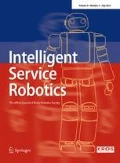Abstract
In this research, we propose an innovative robotic platform for clinical tests suitable for small- or medium-sized laboratories using small-sized multiple mobile robots and a robotic arm. The robotic platform, called “BioRobot Platform,” allows us to run a test process more flexibly than traditional sequential test procedures using conveyor belts by simultaneously conducting various clinical tests through multiple mobile agents. It also improves productivity (the number of tests conducted in time) by having controllable throughput according to amount of tests. Moreover, to operate the entire hardware and several mobile agents concurrently, the various algorithms related to robotic technologies such as motion control, localization, and path planning algorithm are applied to the platform. To evaluate the performance of the BioRobot Platform, various control methods are implemented, which provides parallel processing and scalability. The feasibility of the BioRobot Platform with three mobile robotic agents is validated through preliminary experiments.























Similar content being viewed by others
References
Sasaki M, Kageoka T, Ogura K, Kataoka H, Ueta T, Sugihara S (1998) Total laboratory automation in Japan past, present and the future. Clin Chim Acta 278:217–227
Boyd JC, Felder RA, Savory J (1996) Robotics and the changing face of the clinical laboratory. Clin Chem 42:1901–1910
Holman JW, Mifflin TE, Felder RA, Demers LM (2002) Evaluation of an automated preanalytical robotic workstation at two academic health centers. Clin Chem 48(3):540–548
Bauer S, Teplitz C (1995) Total lab automation: system design. Med Lab Obs 27:44–50
Bauer S, Teplitz C (1995) Total laboratory automation: a view of the 21st century. Med Lab Obs 27:22–25
Zakowski J, Powell D (1999) The future of automation in clinical laboratories. IVD Technology Magazine, pp 48–59
Felder RA, Kost GJ (1998) Modular stepwise automation. Med Lab Obs 30:22–27
Graves S, Holman B, Felder RA (2000) Modular robotic workcell for coagulation analysis. Clin Chem 45(5):772–777
Felder RA, Kost GJ (1998) Modular stepwise automation and the future of diagnostic testing. Med Lab Obs 30:46–56
Felder RA (1998) Modular workcells: modern methods for laboratory automation. Clin Chim Acta 278:257–267
Graves S, Holman H, Rossetti M, Estey C, Felder RA (1998) Robotic automation of coagulation analysis. Clin Chim Acta 278:269–279
Boyd J (2002) Robotic laboratory automation. Science 295(5554):517–518
Petersen R, Bissell MG (1998) Leveling the playing field: the economics of robotics in the hospital clinical lab. Med Lab Obs 30:42–45
Meldrum DR, Fisher CH, Moore MP, Saini M, Holl MR, Pence WH, Moody SE, Cunningham DL, Wiktor PJ (2003) ACAPELLA-5K, a high-throughput automated genome and chemical analysis system. In: International conference on intelligent robots and systems, pp 2321–2328
ABAXIS. Piccolo Xpress\(^{\textregistered }\). http://www.piccoloxpre-ss.com
You WS, Park JJ, Jin SM, Ryew SM, Choi HR (2014) Point-of-care test equipment for flexible laboratory automation. J Lab Autom 19(4):403–412
Choi BJ, You WS, Shin SH, Moon H, Koo JC, Chung WK, Choi HR (2010) Robotic laboratory automation platform based on mobile agents for flexible clinical tests. In: 2010 IEEE international conference on automation science and engineering (CASE), pp 186–191
Choi BJ, Jin SM, Shin SH, Koo JC, Ryew SM, Kim JH, Son WH, Ahn KT, Chung WK, Choi HR (2008) Development of flexible BioRobot Platform for integrated clinical test. J Assoc Lab Autom 13(2):90–96
Bissell MG, Petersen JR (1998) Automated integration of clinical laboratories: a reference. AACC Press, Washington
Banki Z, Bathor M, Molnar L, Bielik A, Keseru GM (2005) Scheduling fexible, open-architecture robotic workstation under labwindows. J Assoc Lab Autom 10(3):149–154
Shin SH, Choi BJ, Ryew SM, Kim JH, Kim DS, Chung WK, Choi HR, Koo JC (2010) Development of an improved scheduling algorithm for lab test operations on a small-sized BioRobot Platform. J Assoc Lab Autom 15(1):15–24
Choi BJ, Jin SM, Shin SH, Koo JC, Ryew SM, Kim J, Shon WH, Ahn KT, Chung WK, Choi HR (2008) Development of flexible laboratory automation platform using mobile agents in the clinical laboratory. In: Proceedings of IEEE international conference on automation science and engineering, pp 918–923
Schafer R (2004) Concepts for dynamic scheduling in the laboratory. J Assoc Lab Autom 9(6):382–397
Seaberg RS, Stallone RO, Statland BE (2000) The role of total laboratory automation in a consolidated laboratory network. Clin Chem 46(5):751–756
You WS, Choi BJ, Kim B, Moon H, Koo JC, Chung WK, Choi HR (2010) Global localization for a small mobile robot using magnetic patterns. In: 2010 IEEE international conference on robotics and automation (ICRA), pp 2618–2623
You WS, Choi BJ, Choi HR, Koo JC, Moon H (2014) Localization using magnetic patterns for autonomous mobile robot. Int J Adv Robot Syst 11(3):50
Koenig S, Likhachev M (2002) Improved fast replanning for robot navigation in unknown terrain. In: Proceedings of the IEEE international conference on robotics and automation (ICRA), pp 968–975
Koenig S, Likhachev M (2005) Fast replanning for navigation in unknown terrain. Trans Robot 21(3):354–363
Likhachev M, Ferguson D, Gordon G, Stentz A, Thrun S (2005) Anytime dynamic A*: an anytime, replanning algorithm. In: Proceedings of the international conference on automated planning and scheduling (ICAPS)
Kim JW, Choi BJ, Noh KH, Choi HR, Koo JC, Ryew SM, Kim JH, Son WH (2006) Automatic scheduling algorithm for personalized clinical test. In: SICE-ICASE international joint conference, pp 5823–5827
Shin SH, Choi BJ, Ryew SM, Kim JW, Kim DS, Chung WK, Choi HR, Koo JC (2010) Development of an improved scheduling algorithm for lab test operations on a small-size BioRobot Platform. J Assoc Lab Autom 15(1):15–24
Acknowledgements
This research was supported by a Grant (Code R2016001) from Gyeonggi Technology Development Program funded by Gyeonggi Province, and Basic Science Research Program through the National Research Foundation of Korea (NRF) funded by the Ministry of Education (No. NRF-2016R1A6A3A11933722).
Author information
Authors and Affiliations
Corresponding author
Rights and permissions
About this article
Cite this article
You, W.S., Choi, B.J., Moon, H. et al. Robotic laboratory automation platform based on mobile agents for clinical chemistry. Intel Serv Robotics 10, 347–362 (2017). https://doi.org/10.1007/s11370-017-0233-x
Received:
Accepted:
Published:
Issue Date:
DOI: https://doi.org/10.1007/s11370-017-0233-x




